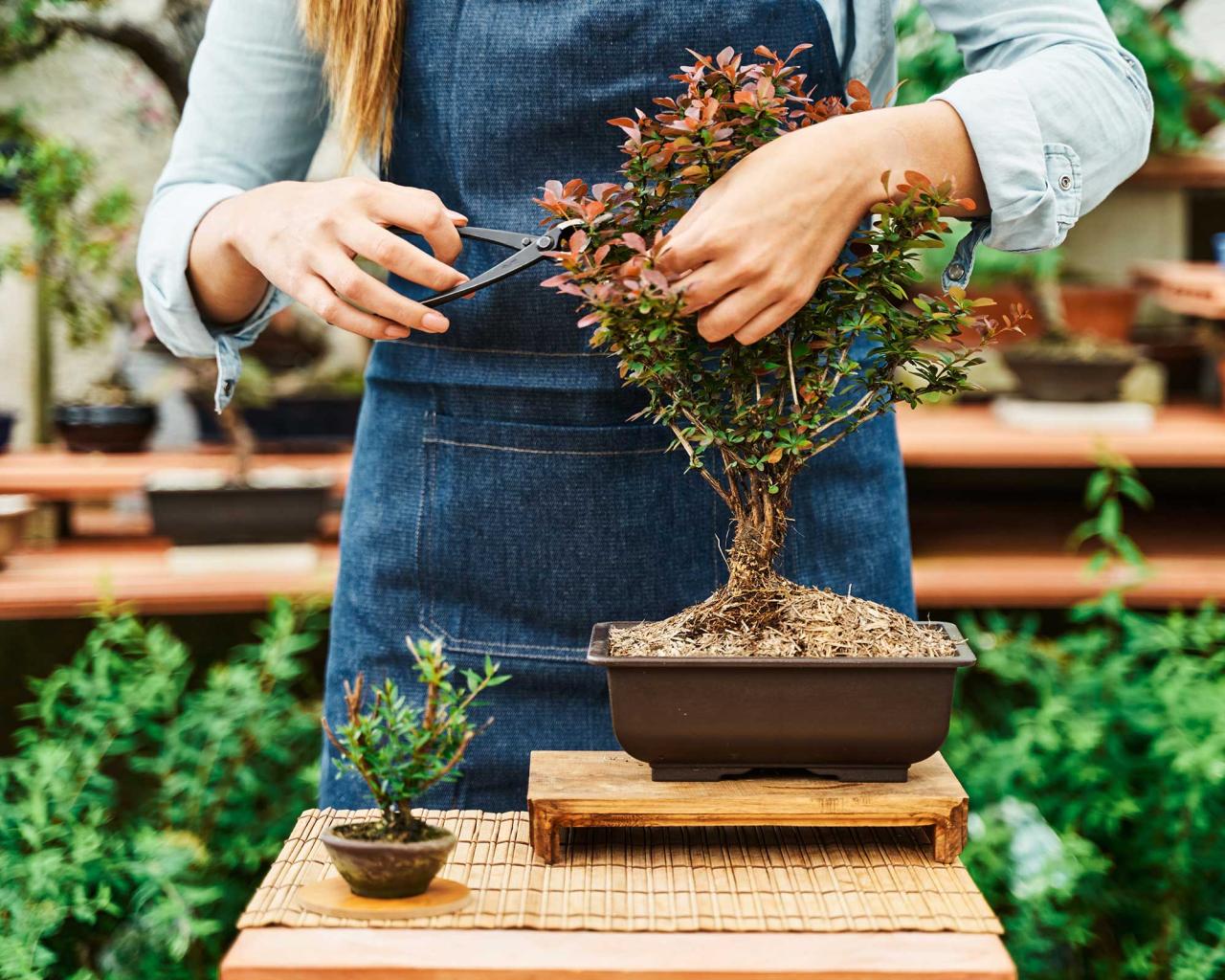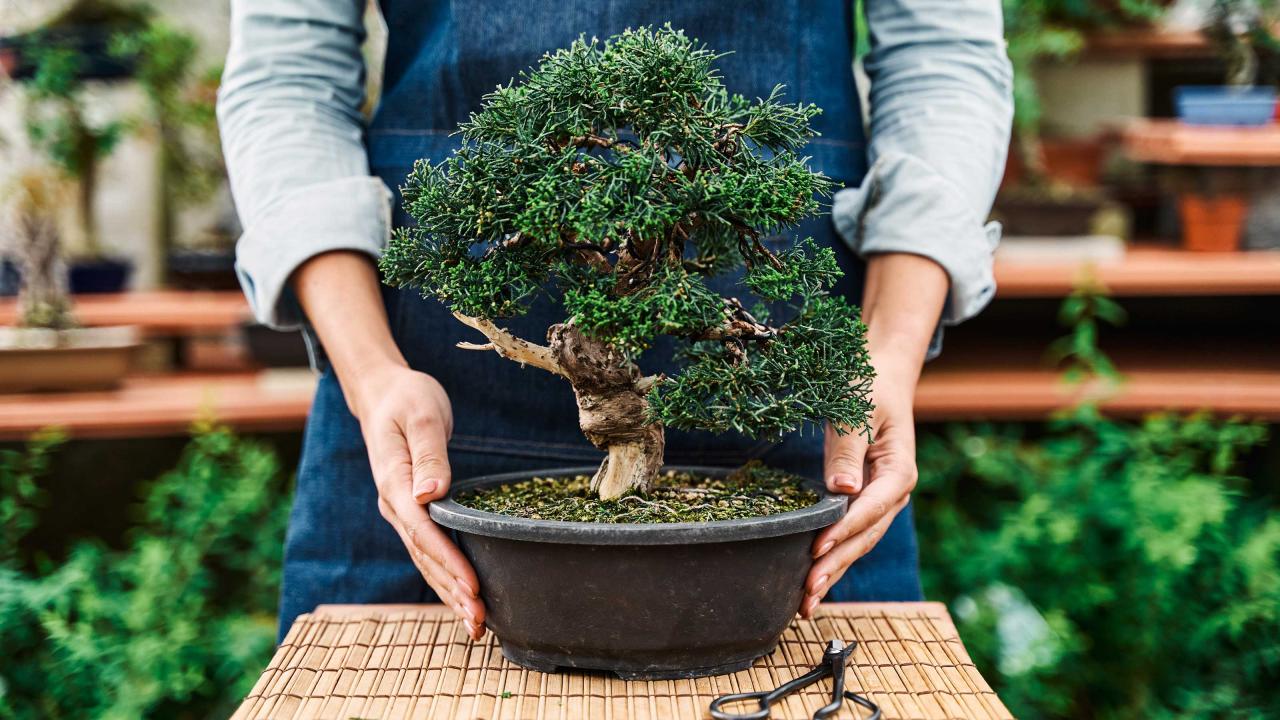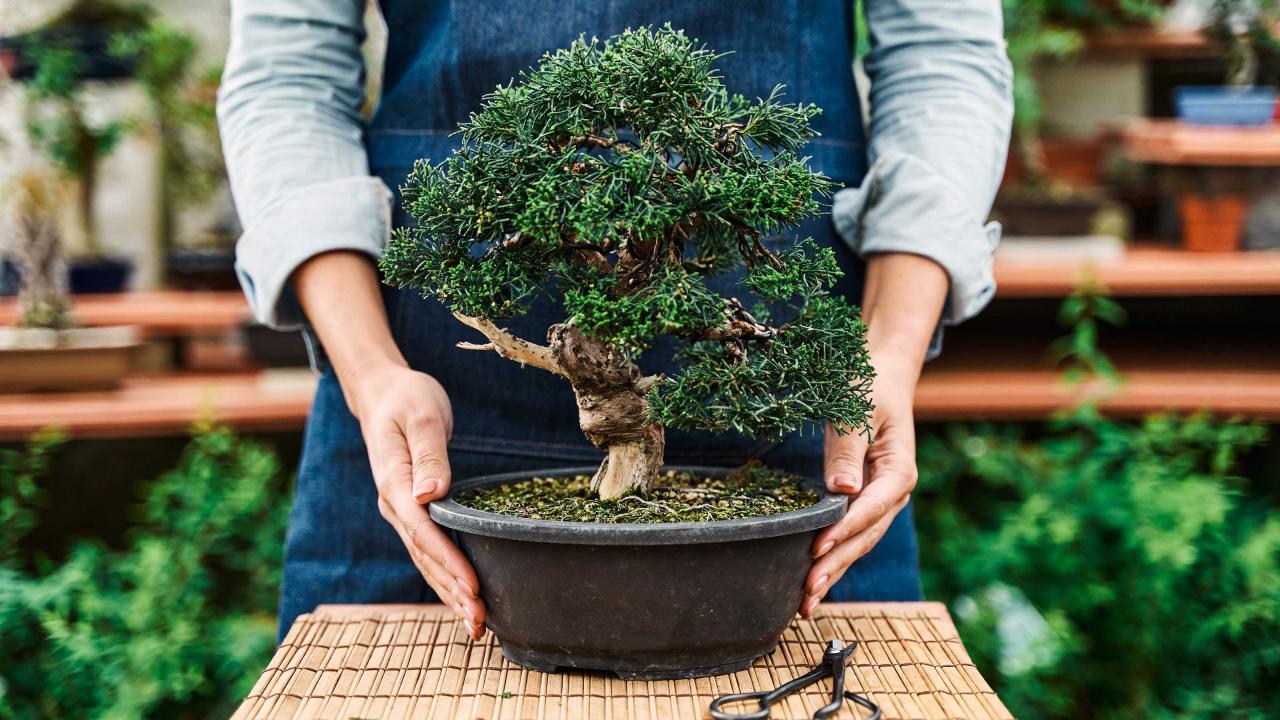Bonsai Care Tips for Growing Strong and Healthy Trees: The art of bonsai is a captivating blend of patience, skill, and appreciation for nature’s miniature masterpieces. These living sculptures, meticulously crafted from trees, require a deep understanding of their unique needs and a commitment to providing the ideal environment for their growth and health.
This comprehensive guide delves into the essential aspects of bonsai care, offering practical tips and insights to help you cultivate thriving bonsai trees that will bring years of beauty and tranquility to your home.
From selecting the right bonsai tree species to mastering the art of pruning and shaping, this guide will empower you to become a successful bonsai enthusiast. We will explore the intricacies of bonsai potting and soil, the importance of proper watering and fertilization, and the techniques for addressing common bonsai problems.
With a little dedication and the right knowledge, you can cultivate bonsai trees that are not only visually stunning but also thriving examples of horticultural artistry.
Choosing the Right Bonsai Tree: Bonsai Care Tips For Growing Strong And Healthy Trees

Embarking on the bonsai journey requires careful consideration of the tree species you choose. Selecting the right bonsai tree is crucial for its long-term health and your success as a bonsai enthusiast.
Factors to Consider When Selecting a Bonsai Tree
Choosing a bonsai tree is a personal decision, influenced by your experience level, available space, and desired aesthetic.
- Experience Level:Beginners should opt for hardy and forgiving species like the Chinese Elm or Japanese Black Pine, known for their resilience and adaptability. Experienced bonsai enthusiasts can explore more challenging species like the Japanese Maple or Ficus.
- Available Space:Bonsai trees come in various sizes, from miniature to large. Consider the space you have available for your bonsai and choose a species that will fit comfortably in your home or garden.
- Desired Aesthetic:Bonsai trees offer a wide range of styles, from the classic upright to the cascading and informal upright. Determine the aesthetic you desire and choose a species that can be trained to achieve that style.
Popular Bonsai Tree Species
Here is a list of popular bonsai tree species, highlighting their unique characteristics, growth habits, and care requirements.
- Chinese Elm (Ulmus parvifolia):A hardy and fast-growing species, the Chinese Elm is well-suited for beginners. It tolerates a wide range of conditions and is known for its attractive foliage and intricate branching patterns.
- Japanese Black Pine (Pinus thunbergii):A classic bonsai species, the Japanese Black Pine is known for its rugged beauty and dark green needles. It is a challenging species to maintain but rewards the bonsai enthusiast with a stunning tree.
- Japanese Maple (Acer palmatum):A popular choice for its delicate foliage and vibrant fall colors, the Japanese Maple is a beautiful and rewarding bonsai species. It is known for its slow growth rate and intricate branching patterns.
- Ficus (Ficus benjamina):A tropical species, the Ficus is known for its glossy leaves and weeping branches. It is a popular choice for beginners due to its relatively easy care requirements. However, it requires high humidity and indirect sunlight.
- Juniper (Juniperus):A versatile and resilient species, the Juniper is well-suited for both indoor and outdoor bonsai cultivation. It is known for its compact growth habit and attractive blue-green foliage.
Choosing a Healthy Bonsai Tree
It is crucial to choose a healthy bonsai tree from a reputable source. Look for a tree with vibrant foliage, healthy roots, and no signs of pests or diseases. A reputable bonsai nursery or dealer will be able to provide you with information on the tree’s origin, care requirements, and any potential problems.
Understanding Bonsai Potting and Soil

Bonsai trees, despite their miniature size, require a specific environment to thrive. This environment includes the pot they are planted in and the soil they grow in. Choosing the right pot and soil is crucial for the health and longevity of your bonsai tree.
Bonsai Pot Features
The bonsai pot plays a vital role in the tree’s growth and aesthetics. Here are some key features to consider:
- Size:The pot should be proportionate to the size of the tree. A general rule of thumb is that the pot should be about one-third to one-half the width of the tree’s canopy. A pot that is too large will encourage excessive root growth, while a pot that is too small will restrict root development and lead to nutrient deficiencies.
- Drainage:Good drainage is essential for bonsai trees. The pot should have drainage holes to prevent waterlogging, which can lead to root rot. The size and number of drainage holes will depend on the size of the pot and the type of soil used.
- Material:Bonsai pots are made from a variety of materials, including ceramic, glazed ceramic, plastic, and wood. Each material has its own advantages and disadvantages. Ceramic pots are durable and aesthetically pleasing, but they can dry out quickly. Glazed ceramic pots are less porous and retain moisture better, but they can also be more expensive.
Plastic pots are lightweight and affordable, but they can be less aesthetically pleasing. Wooden pots are natural and attractive, but they can be susceptible to rot if not properly cared for.
Bonsai Soil Properties
Bonsai soil is specifically formulated to provide optimal drainage and aeration for bonsai trees. It typically consists of a mixture of inorganic materials, such as pumice, akadama, and lava rock, along with organic matter, such as peat moss or compost.
- Drainage:The soil must allow for good drainage to prevent waterlogging. Inorganic materials like pumice and akadama provide excellent drainage, while organic matter helps retain moisture. The ideal soil mix will retain enough moisture to keep the roots hydrated but allow excess water to drain away quickly.
- Nutrient Content:Bonsai soil should contain a balance of nutrients to support the tree’s growth. Organic matter, such as peat moss or compost, provides essential nutrients. You can also supplement the soil with fertilizers to ensure the tree has adequate nutrients.
Repotting a Bonsai Tree
Repotting is essential for the health of a bonsai tree. It allows you to refresh the soil, prune the roots, and adjust the tree’s position in the pot.
- Timing:The best time to repot a bonsai tree is during its dormant period, typically in late winter or early spring, before new growth begins. Avoid repotting during the summer months when the tree is actively growing.
- Techniques:Repotting a bonsai tree requires careful handling. First, gently remove the tree from its current pot, being careful not to damage the roots. Next, prune any damaged or overgrown roots. Finally, place the tree in its new pot, ensuring that the soil level is the same as it was in the previous pot.
- Tools:You will need a few tools to repot a bonsai tree, including:
- A sharp knife or pruning shears
- A bonsai pot
- Bonsai soil
- A watering can
Essential Bonsai Care Practices
The journey to cultivating a thriving bonsai tree involves a consistent and dedicated approach to its care. These practices are not just about ensuring the tree’s survival but also about nurturing its growth and shaping its aesthetic appeal.
Watering
Watering is a crucial aspect of bonsai care. The frequency of watering depends on various factors such as the tree species, pot size, climate, and season. Bonsai trees require a consistent moisture level, avoiding both overwatering and underwatering.
- Frequency:Water when the top inch of soil feels dry to the touch. During hot weather or periods of active growth, watering may be required more frequently.
- Technique:Water thoroughly until excess water drains out of the drainage holes. Avoid letting the soil become completely dry or waterlogged.
- Signs of Overwatering:Yellowing leaves, drooping stems, and mold growth on the soil surface.
- Signs of Underwatering:Wilting leaves, dry soil, and leaf drop.
Fertilization
Bonsai trees require regular fertilization to provide them with essential nutrients for healthy growth. However, overfertilization can be detrimental.
- Frequency:Fertilize every two to four weeks during the growing season (spring and summer). Reduce fertilization frequency during winter dormancy.
- Type of Fertilizer:Use a balanced liquid fertilizer specifically formulated for bonsai trees. Avoid fertilizers high in nitrogen, as they can promote excessive foliage growth.
- Signs of Nutrient Deficiency:Yellowing or discolored leaves, stunted growth, and weak branches.
Pruning
Pruning is a fundamental bonsai technique used to shape the tree, control its growth, and maintain its overall health.
- Types of Pruning:Bonsai pruning involves various techniques such as pinching, trimming, defoliation, and root pruning. These techniques are used to control the size and shape of the tree.
- Timing:Pruning is generally performed during the growing season, when the tree is actively growing. However, specific pruning techniques may be carried out at different times of the year.
- Tools:Use sharp, clean pruning tools to prevent damage and disease transmission.
Lighting
Bonsai trees need adequate sunlight to thrive. However, the amount of sunlight required varies depending on the species.
- Sunlight Requirements:Most bonsai trees need at least six hours of sunlight per day. However, some species prefer partial shade.
- Location:Place your bonsai tree in a location that receives adequate sunlight. Rotate the pot regularly to ensure even growth on all sides.
- Signs of Insufficient Light:Pale leaves, elongated growth, and weak stems.
Temperature
Temperature plays a significant role in the health and growth of bonsai trees. Bonsai trees are generally adapted to the climate they originated from.
- Temperature Range:Most bonsai trees thrive in temperatures between 60-80°F (15-27°C). However, some species may tolerate colder or warmer temperatures.
- Winter Dormancy:Many bonsai trees require a period of winter dormancy at cooler temperatures (around 40°F or 4°C) to promote healthy growth in the following year.
- Signs of Temperature Stress:Leaf drop, wilting, and stunted growth.
Recognizing Bonsai Problems
Recognizing and addressing common bonsai problems is crucial for maintaining the health and beauty of your tree. Early detection and intervention can prevent serious issues from developing.
Pests
- Common Pests:Aphids, scale insects, spider mites, and mealybugs.
- Signs of Infestation:Visible insects, sticky residue on leaves, and distorted growth.
- Treatment:Use insecticidal soap or horticultural oil to control pests.
Diseases
- Common Diseases:Root rot, fungal leaf spot, and powdery mildew.
- Signs of Disease:Leaf discoloration, wilting, and lesions on leaves or stems.
- Treatment:Treat fungal diseases with fungicides. Avoid overwatering to prevent root rot.
Nutrient Deficiencies, Bonsai Care Tips for Growing Strong and Healthy Trees
- Common Deficiencies:Nitrogen, phosphorus, potassium, and iron.
- Signs of Deficiency:Yellowing leaves, stunted growth, and weak branches.
- Treatment:Use a balanced fertilizer specifically formulated for bonsai trees to address nutrient deficiencies.
Maintaining Bonsai Health and Vitality
Ensuring your bonsai tree thrives requires more than just basic care. Understanding the signs of illness, pests, and recognizing the need for regular maintenance are crucial for maintaining a healthy and vibrant bonsai. This section delves into the critical aspects of bonsai health and vitality, covering disease and pest diagnosis, the importance of regular maintenance practices, and the role of these practices in promoting the long-term health and longevity of your bonsai.
Diagnosing and Treating Common Bonsai Diseases and Pest Infestations
Identifying and treating diseases and pest infestations early is crucial for preventing significant damage to your bonsai. Recognizing the signs of common problems will help you take prompt action to protect your tree.
- Fungal Diseases:These are common in bonsai, often caused by excessive humidity or poor drainage. Signs include leaf spots, discoloration, wilting, and root rot. Treatment typically involves removing infected parts, improving drainage, and applying fungicides.
- Bacterial Diseases:Bacterial infections can cause leaf blight, stem cankers, and root rot. Treatment often involves pruning infected parts, improving air circulation, and applying bactericides.
- Viral Diseases:While less common, viral diseases can cause mosaic patterns on leaves, stunted growth, and deformed branches. Unfortunately, there is no cure for viral diseases; infected trees should be removed to prevent spreading.
- Insect Pests:Various insects can infest bonsai, causing damage to leaves, stems, and roots. Common pests include aphids, mealybugs, scale insects, and spider mites. Regular inspection and prompt action with insecticidal soap or neem oil can control these pests.
- Mites:Tiny, spider-like creatures that can cause damage to leaves, leaving them discolored and webbed. Treatment involves using a miticide or insecticidal soap.
Importance of Regular Bonsai Maintenance
Regular maintenance is essential for the long-term health and vitality of your bonsai. It involves a series of practices that ensure the tree receives the necessary care to thrive.
- Cleaning:Regular cleaning helps remove debris, dust, and pests. This can be achieved by gently wiping leaves with a damp cloth or spraying with water.
- Watering:Bonsai require consistent watering, ensuring the soil remains moist but not waterlogged. The frequency of watering depends on factors such as pot size, soil type, and climate.
- Fertilization:Bonsai need regular fertilization to provide the necessary nutrients for healthy growth. Use a balanced fertilizer specifically formulated for bonsai trees. The frequency and amount of fertilizer will vary based on the tree’s species, growth stage, and season.
Role of Bonsai Care in Promoting Long-Term Health and Longevity
Proper bonsai care practices play a crucial role in promoting the long-term health and longevity of your bonsai tree. These practices not only ensure the tree’s survival but also contribute to its overall well-being and aesthetic appeal.
- Disease Prevention:Regular maintenance, such as cleaning and proper watering, helps prevent disease by maintaining a healthy environment for the tree. Early detection and treatment of any disease can significantly reduce the risk of serious damage.
- Pest Control:Regular inspections and prompt action against pests help prevent infestations from becoming uncontrollable, minimizing damage to the tree.
- Optimal Growth Conditions:Consistent watering, proper fertilization, and appropriate lighting create an environment that promotes healthy growth, enabling the bonsai to thrive and develop a strong root system.
- Stress Reduction:Regular maintenance practices help reduce stress on the bonsai tree, enabling it to withstand environmental changes and other challenges.
Summary
As you embark on your bonsai journey, remember that patience and perseverance are key. Embrace the challenge of nurturing these delicate trees, and you will be rewarded with the immense satisfaction of witnessing their growth and evolution over time.
Bonsai care is a rewarding experience that fosters a deep connection with nature, allowing you to appreciate the beauty and resilience of these miniature wonders. So, dive into the world of bonsai and discover the joy of cultivating these living works of art.
FAQ Overview
What are the best bonsai trees for beginners?
For beginners, consider species like Chinese Elm, Japanese Black Pine, or Ficus. These are relatively easy to care for and offer a good starting point for bonsai cultivation.
How often should I water my bonsai tree?
Watering frequency depends on the species, pot size, and environmental conditions. Check the soil moisture regularly and water thoroughly when it’s dry. Avoid overwatering, which can lead to root rot.
What kind of fertilizer should I use for my bonsai?
Use a balanced, water-soluble fertilizer specifically formulated for bonsai trees. Follow the instructions on the product label for application rates and frequency.
